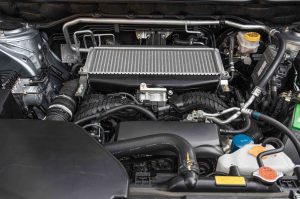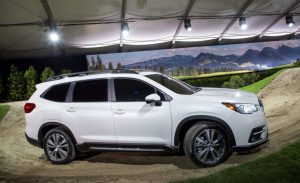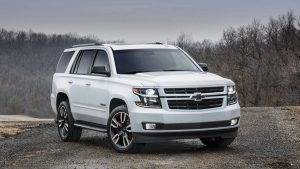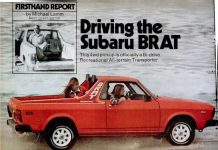One of the many cons being perpetrated upon the car-buying public is that the very small, very turbocharged four cylinder engines being served up as replacements for “thirsty” V6 and even V8 engines in larger vehicles especially are money-savers.
Hell, they hardly save much gas.
And they cost in other – hidden – ways.
Consider, as an example of the trend, the stats of the 2019 Subaru Ascent vs. those of the Chevy Tahoe. The former is representative of the New School while the Chevy is as Old School as it gets in anything new.
Both are big – and heavy – vehicles. Each seat up to eight people in three rows. But the Ascent – which is a car-based crossover SUV – has a very small-for-its-size engine, just 2.4 liters and 260 hp to haul around its 4,430 lbs. (that’s empty, before even the driver climbs on board). The EPA says it gets 20 city, 26 highway – best case.
I have been test-driving this vehicle for several days and am averaging 22.8 MPG, according to the car’s computer.
The Tahoe is also a big vehicle and a much heavier vehicle – by more than 1,000 lbs. Because it’s a truck-based SUV, with a heavier-duty frame and truck-type 4WD gear (including a two-speed transfer case) vs. the Subaru’s lighter-duty all-wheel-drive system. Unlike the Soobie, the Chevy has a big V8 under its hood – 5.3 liters and 355 horsepower, which is more than twice the size of the Subaru’s engine and almost 100 hp stronger.
And yet, it hardly uses much more gas.
The EPA says 16 city, 23 highway – which amounts to a difference without much distinction of just 4 MPG in city driving and 3 MPG on the highway. I’ve driven several new Tahoes over the years and they also average about what what the Soobie averages.
But the Chevy is much stronger, much more capable vehicle. For example, it can tow 8,400 lbs. vs. several thousand pounds less for the Subaru.
And much quicker, too.
Zero to 60 in just 5.8 seconds vs. 7.3 seconds for the lighter, smaller-engined, but not-much-smaller Subaru (which is about 197 inches long overall vs. 204 inches for the Tahoe).
So, what’s the upside to the Subaru’s downsized engine? It is hard to figure.
It is becoming practice to put undersized engines in overisized vehicles. Mazda, for example, sells a vehicle that is a direct apples-to-apples cross shop of the Ascent, the CX-9. It is also a large, car-based crossover SUV with three rows of seats . . . and a very small (2.5 liters) engine under its hood.
It also rates 20 city, 26 highway according to the EPA – like its Subaru rival.
Now, vehicles like the Ascent and the CX-9 never came with V8s; that would be over-engining them. But they did used to come with size-appropriate V6 engines and – shocking, as Geraldo used to say all the time – they didn’t use much more fuel, either.
For example, the 2015 Mazda CX-9, which was available with a 3.7 liter V6, rated 17 city, 24 highway – a difference of 3 MPG in city driving and just 2 MPG on the highway. It’s such a small difference as to make no meaningful difference – in terms of what you paid for gas.
Power/performance is one way.
The CX-9’s no-longer-available 3.7 liter V6 was much stronger than the turbo 2.5 liter four which replaced it – 273 hp then vs. 225 hp now, a difference of almost 50 hp, which is a difference with a distinction.
Another is stress – and expense.
Undersized engines rely on turbo boost as the replacement for displacement. The theory is that you’ll use less gas when the engine isn’t being turbo-boosted. Which is fine – and true – when the engine is idling and the car isn’t moving.
The reality is that because the engines are too small (and not strong enough on their own) to adequately propel the vehicles they’re tasked with moving, they are on boost almost all the time once they’re not sitting still. The turbo boosts the power to adequate-engine levels, but also results in about the same amount of fuel being used by an engine that is working harder to make it and meanwhile, as a result, its internal parts are subjected to higher stress because of the higher pressure experienced inside a turbo engine.
An engine that isn’t turbocharged sucks air into its cylinder via the vacuum – negative pressure – created by the pistons as they travel downward, inhaling (so to speak) the air that will be mixed with fuel to create the explosion which makes the power to propel the vehicle. A turbocharged engine is force-fed air, which is crammed into its cylinders under positive pressure (boost) which is typically in the range of 18-22 pounds per square inch.
Turbocharged engines can be built with tougher internals, to withstand the additional pressure – but the fact remains they are subjected to higher pressure (and stress) than engines which are not force-fed air. And no matter how tough-built they are, they are built with additional parts – the turbocharger and all its related bits and pieces. This adds certain expense up front – when you buy the car so equipped – and at least possible expense down the road, in the event a problem develops with the turbo and/or any of its related bits and pieces.
It is impossible for such problems to develop with a non-turbocharged engine, because there is no turbo – nor turbo-related bits and pieces, either.
This is why – historically – turbocharged engines were used almost exclusively as power-enhancers (rather the displacement replacers) in high-performance vehicles, usually sports cars and sport sedans.
Now they are being used in mass-market, daily-driven family vehicles like the Ascent and CX-9 and many others.
All for the sake of maybe 3-4 MPG.
On paper.
Which makes no sense except in the context of the car companies being desperate to eke out fractional fuel efficiency gains, in order to keep pace with the government’s none-of-its-business demands that our new cars get ever-higher-mileage.
No matter how little it actually turns out to be – and regardless of how much it costs us.
. . .
Got a question about cars – or anything else? Click on the “ask Eric” link and send ’em in!
If you like what you’ve found here, please consider supporting EPautos.
We depend on you to keep the wheels turning!
Our donate button is here.
If you prefer not to use PayPal, our mailing address is:
EPautos
721 Hummingbird Lane SE
Copper Hill, VA 24079
PS: EPautos magnets are free to those who send in $20 or more. My latest eBook is also available for your favorite price – free! Click here. If you find it useful, consider contributing a couple of bucks! 














I saw this vid on Youtube and immediately knew I had to post it here! He really goes into detail on why these engines, as Eric has also eluded to, are not efficient in real world scenarios. Great Youtube channel overall that talks about engineering and they’re all (from what I’ve seen) auto-related.
https://www.youtube.com/watch?v=9aO2vC_iMTI
Hi C_dub,
Have a look at the latest car review – 2018 Mitsubishi Outlander Sport. No turbos… and it delivers at least as good gas mileage with better performance than some of its turbocharged/smaller-engined rivals.
Will do. Hopefully it starts a trend back in the direction of sanity.
The Motto of the Bureaucrat: “I don’t care how much extra it costs you to follow my rules.”
The Ford Mustang GT 2007 I used to own would get me 29 MPG on a V-8! And of course, no damn turbo was needed. And neither was ethanol-laced fuel.
The Mazda MX-5 that I just got gets the same 29 MPG on a 4-cylinder engine with Premium fuel “suggested”. Which sounds like a subtle way of saying recommended or required.
It makes me wish I could have saved the Mustang from the crusher and just swapped the V-8 into the Miata. If I could make it fit. The holes are probably in the wrong place.
Hi Travis,
Amen.
I’ve mentioned before that my ’76 Trans Am is capable of high teens- with a carbureted 7.5 liter V8. All I did to achieve that was add an overdrive transmission.
Put another way, it is capable of mileage only slightly worse than the Subaru Ascent I just spent a week in… which has a turbocharged 2.4 liter engine with direct injection and all the other “high tech” equipment.
It’s absurd.
The LS swap is very popular. This guy did one, and documented the process on his YouTube channel: https://youtu.be/gDMrJhpeYiE
Hi Myles,
The LS seems to be the go-to engine for retro swaps – and I get why. It is a very powerful, tightly-packaged and basically simple engine that fits in almost anything. But I miss the variety of the old days, when you had Mopars and Buicks and Oldsmobiles and Pontiacs…with Buick and Oldsmobile and Pontiac engines!
I wonder…over the expected life span, how much of the fractional gains in efficiency of these turbo charged micro engines is eaten up by the energy expended to mine, smelt, cast, machine and transport all the extra parts related to the turbocharger?
This is where the rubber meets the road regarding the great ethanol scam, the electric car battery scam and the recycling scam.
It would not surprise me in the least to find out that the same thig applies here: more energy used to make the extra, sophisticated and beefed up parts than what is saved in the long run on fuel consumption.
I have a 2014 F150 4×4 crew cab with the 5.0. It has 38 k on it and it has averaged 18.8 mpg and gets 21.2 on the interstate. Now my step father owns a 2016 F150 4×4 Crew cab with the 3.5 ecoboost. He is lucky to average 16.5 mpg and he has a lighter foot. They can keep the turbos. I will stick with the bigger engine that works less harder.
Hi Allen,
Yup – my experience has been the same. I have driven the F-truck with the V8 and the turbo V6. No appreciable difference in mileage. The 3.5 EcoBoost does have more low-end torque, but that is chiefly because Ford’s remaining (5.0) V8 is relatively small. The torque output of GM’s 6.2 V8 more than delivers the goods… without turbos.
Here are two points that I’d enjoy seeing you address:
Torque. You buy horsepower, you drive torque. All this sewing machine engines are low torque, meaning that even if the engine develops 260 HP, it still only has 200 ft lbs of torque – which isn’t much.
Computer control, fly by wire, and delayed acceleration. In the bad old days the accelerator was mechanically linked to the throttle on the carburetor. That’s no longer true (unintended acceleration errors occur). Now when you step on the go-pedal, the request is transmitted to a computer system which is able to delay your demand for instant gratification and modify it into a more gradual application of the accelerator pedal. This will translate into better mileage and fulfill some bureaucrat’s need for control over the great unwashed.
Your observation about turbo charging is a good one, and something that the vast majority of people aren’t aware of. Just wait until their turbo unit blows a seal, or a rod finally lets go. The truth is that even if you use a multi-valve interference engine with a supercharger unit, it still won’t perform as well as a V-8.
Hi Jack,
Thanks for the questions! Some will be addressed in the review of the ’19 Ascent (almost ready) and the rest in a separate column.
To be clear: As with air bags and so many other things, it’s not the technology per se that annoys me. It’s the way government mandates have distorted the application or force-fed them to us.
Nothing wrong with air bags, for example – if people aren’t made to buy them.
And the same with turbos/small engines. Both have their good points, singly or together. The problem arises only because of government mandates which have made their application ridiculous – as in the case of using a 2.5 liter engine in a 5,000 pound vehicle.
I’ve only ever driven one turbo-charged car in my life, an early ’80’s Porsche 911 (930) “widow-maker”. The thing I remember most was the turbo-lag. When that thing would kick in midway through a curve it made for one exciting ride! Do the new turbo’s not have that lag?
Hi Bill,
Turbo lag has been almost entirely eliminated by snugging the turbo (sometimes two small turbos) up against the exhaust port so as to generate almost immediate boost.
The difference now vs. then is that the turbos are meant to make up for lost displacement rather than make additional power.
This quest for efficiency becomes ant f***ing after all the easy stuff is done. But the bureaucrats live for that incremental improvement. 0.5% improvement here, 0.2% improvement there, and pretty soon you’re looking at “major” 0.7% gains. Hallelujah! Nearly a 1% increase in efficiency, if you round up for the power point slide. And don’t forget that much of the reason for the 2.5 cyl 4 bangers is because of Eurozone fatwas restricting engine sizes.
But anyone who has a basic understanding of Newtonian physics knows that to move a mass (M) requires a certain amount of force (F) to be applied. It doesn’t matter if the force is from 8 cylinders, 4 cylinders or human legs. If you want to accelerate M you need to apply F.
So if the F comes from a chemical burn of hydrocarbons, the energy stored in those molecules is also measurable. Again, there’s a given amount of potential energy in the fuel (Kilocalories, C). So if you want to (A)ccelerate (M)ass you need to figure out how many (C)alories it takes to apply enough (F)orce. CF=MA I think. Probably should have used joules and foot-pounds (and paid more attention in class), but hey I’m just a cable guy.
No amount of legislation will change physics. In fact, it seems that legislation has caused negative gains due to the added weight, reduction of the stored energy in fuel, and increased wear (friction) on small high-revving engines.
Your point is a good one RK, and one which I feel especially applies to electric cars, where you are moving around tons of extra weight (whether full or empty). With F=MxA, with more M, for the same A you will need materially more F at all times…. and thats before energy wastage of about 10%per day when an electric car sits there…. but then again im just an accountant and WTF do I know…. Im sure some government employee wiser than us has regulated around the laws of physics….
Not bad for a cable guy, and I am an engineer. You nailed it.
My 2012 Outback with the 3.6L H6 gets slightly better mileage than my 2003 Outback with the 2.5L H4. This is in the real world. And in the real world, there is a noticeable difference in power.
Which makes me wonder: if this is so, why didn’t Subaru put the 6 in its Ascent, or make it an option? The 6 was available in the Tribeca.
If Subaru drops the 6, I will be likely only getting their small cars.
I guess I am fortunate that my new Atlas has the V-6, no turbo. I don’t feel it is under-engined at all, I can hypermile up to 30mpg with it, but usually, it gets 23-24 in mixed driving. I am not unhappy. They have the 2.0l Turbo in that car, which to me is insane but the trends force by those DC psychos.
My next door neighbor just showed me his bill for a Prius battery replacement, and the doofus still thinks he is saving money!
Even the Australians are finally catching on to the government edicts that do nothing other than create revenue streams for government but harm the consumers.
https://youtu.be/Ip5rPBi8MaQ
Nothing new here…. we saw the same thing with curly fluorescent light bulbs. Save a bunch on electricity by paying $5 for a bulb to replace the 35 cent one you are using now. On paper, and under controlled testing, yes. But one big thing was the ignorance of the public (even my college educated kids!). They were not also told that every on/off cycle ate into the savings by using up part of the $5 cost. So they wound up in closets and basement stairs and the power savings disappeared as replacement costs skyrocketed. (I am also betting the same thing is lurking someplace in the LED bulbs. Surely, if one drops one during installation the “savings” disappear immediately. At least you don’t need to call the hazmat folks to vacuum your carpet.) It is funny how both of these were, like electric vehicles, jammed down our throats. Have you tried to buy an incandescent of over 25 watts lately?
Man talk about pet peeves! These stupid bulbs are useless, the light is terrible, they really don’t last very long. I have light bulbs in my house that are still original when I built it in 1994! They were el-cheapos made in Poland and like half the price of a GE bulb. The 65 w recessed lights in the hallway and above my fireplace are original, and I have maybe replaced 1/3 of the bathroom vanity fixture bulbs and have never had to change any of the closet bulbs. I wish I could find more of them.
I have heard bad things about the LED’s so I avoid them.
There is a downside to LED bulbs that no one is talking about. LEDs are more susceptible to power surges and fluctuations. You can bet that if there is an EMP strike, most (if not all) LED lamps and other electronic items will be toast.
Most big brick and mortar stores selling these dumb things its harder to find them. Fortunately they still make hard core long lasting incandescent bulbs for industrial use in A9 size for like $0.35 per bulb. Heavy duty, 10,000 hour lifespan.
In Europe, incandescent bulbs have ben outlawed, at least for lighting. These bulbs can still be purchased, being called “heaters”. That is a way around the “law”…
I hear they’re really good at changing light bulbs in Poland! (I’m Polish, FYI)
ARYLIOA:
I stocked up before the defacto ban. I have hundreds of 60W bulbs, hundreds of 40W bulbs, and dozens of 100W bulbs.
There are several issues with “high efficiency” lamps.
1) Color Rendering Index is not as good as incandescent. Incandescent lights with clear bulbs have a perfect (100) CRI. Less CRI means colors look more muted and less vibrant. There are some high CRI LEDs, but these sacrifice efficiency. They advertise color temperature (daylight. soft white, etc.), but always seem to hide CRI. If you are ever going to sell your house – replace all the lamps with incandescent first. It will look better.
2) There is growing medical research showing that our eyes “need” the “wasted” near infrared spectrum produced by incandescent lamps (and the sun BTW) that is missing form any high efficiency light source.
To put is simply, high efficiency lamps may, literally, be driving us blind.
Google it, but here is a question for you: Did anyone ever hear of “Age related macular degeneration” 40 years ago?
Hi Blake,
I wish I had been smart enough to the same… the incandescent replacements impart an autopsy room gloom to every room…
Don’t forget, every one of those CFLs has a drop of mercury in it. Not so “green”, eh?
Metallic mercury is NOT poisonous. It is only when it is heated to over 600 degrees when it can vaporize and become problematic. The scam about metallic mercury being poisonous has been perpetuated by the so-called “environmentalists” and their minions, not unlike the freon R-12 scam…
Hey Eric….. I can already see the next “scandal” brewing in the auto industry….. how far off the real world fuel economy is from the listed fuel economy….. ofcourse the government employees will be ready then as always to be a hero, and to impose their next round of restrictions and money grabs on you and me….
Hi Nasir,
It is, indeed, a fraud. I am test driving the Ascent right now and the best mileage to date is 22.8 on average. In “city” driving, it’s in the mid-high teens.
My ’76 Trans-Am with a 455 V8 hardly uses more gas. No joke. Seriously.
Heres another interesting one, on a website here they have the “real MPG” which is based on people submitting their actual achieved MPG in real life. Interestingly, none of the the new tiny engine big turbo cars are there.
Even more interesting (in line with what you observed with your TransAm)- almost always in the top 5 – none other than the good old Land Rover Defender – the car thats constantly criticised for not keeping up with modern “green” standards…. . Interestingly, under real world conditions, it returns 105% of the listed fuel economy, while all the new LR under engined cars get in the low 80%s at best. The worst is the new discovery sport – which is at 69%.
Check it out here – https://www.honestjohn.co.uk/realmpg/
Excellent, Nasir!
In re the Trans-Am:
It does have one advantage. I installed an overdrive transmission with a deep (.67 I think) OD ratio. But then, most modern cars have that, too.
And they also have direct-injected engines and computers. I have a four barrel carburetor.
But the TA gets remarkably good mileage for what it is – and vs. the new stuff. I think it’s partially due to the TA’s engine being big and torquey and so not needing to really work it much to get good performance. The new stuff you usually have to work hard to get it to perform – and of course, that uses fuel.
Also, new cars are obnoxiously overweight.
My TA – which has a truck-type, bolt-on steel front subframe and a huge cast iron only weighs about 3,800 lbs. A current Dodge Challenger R/T weighs around 4,200 lbs.
And new cars have more rolling resistance due to the gnomesayin’ “rims” and huge tires.
Granted, they enjoy better traction than my TA – with its 15×7 wheels and 245/60-15 tires. But 20-inch wheels and tires creates a lot o’ drag… and those wheels and tires are heavy, too…
It doesn’t hurt using Amsoi either.
In the last several years sun gazing has become more popular. I quit due to circumstance but want to return to it since I can tell the difference.
Yes. At the time of the VW diesel debacle, I though the exact same thing. There is likely software that the automakers have installed to verify the EPA driving cycle. When people actually the gas…well,… your mileage may vary.
The next question is, when will some “consumer” group or magazine test one of these cars and when they don’t live up to the EPA’s “test cycle” results, will claim manufacturers are “cheating” on mileage?
Let’s see, a few hundred billion sucked from the car companies in fines and put in the pockets of the EPA, et al. Sounds like a plan. That should sink a few companies…except good ol’ Tesla.
I’m surprised it hasn’t happened already.
Hi Mark,
I expect it to happen.
People buying these things are going to come to appreciate the truth of the saying, your actual mileage may vary.
Any of that energy star stuff is suspect and highly variable. I put in a new water heater last fall. The label said it should cost about $240/year to run. Since it is natural gas I know that so far this summer it has cost me about $15/month to run, or $180. Of course I leave the thing set very low, in what most would consider vacation setting, and take somewhat cold showers unless I’m sick or hungover. And I live in the Colorado gas patch so my gas price is pretty cheap. I’m certain if I had a woman in the house the water heater would be working much harder than it is.
Unlikely to happen. The federal government test cycle is designed to compare vehicles to each other and need not be a figure that one would achieve in real use. This is the purpose of the sticker fuel economy test and is well known. Automakers are not lying, they are all designing to the test. Well maybe not so much that test but the other fuel economy cycle that is used for CAFE. But both are set up for clovertastic motoring with an egg under the accelerator pedal.
Hi Brent,
Yes. And there is also – lately – needing to figure out a way to reduce C02 “emissions,” which they are package-dealing with MPGs. The small fours – off boost – will potentially “emit” less than a V6 40-50 percent larger in terms of physical displacement.
Brent,
You act as though this will be decided in a court of law that will have to show evidence of harm and the ability to confront your accusers. Oh, no, no, no. That’s not the world we live in today. This will be handled by a faceless bureaucrat with fines being levied as penance for the sin of affronting the Great God GovCo.
These heretics, infidels and non-believers with be dealt with swiftly and surely.
None of these manufacturers are affronting the great government. The CAFE business in part is to have political figures like Obama stand on high and tell people how he gifted them automobiles with greater fuel economy. It’s designed as a scam in that regard. The tests are intentionally the way they are to make the politicians look good. They did the same with the 55mph NMSL.
For 1974 they changed the way fatalities are calculated. So there was this huge drop from that alone, not to mention other factors like the fuel crisis. Now the 55mph NMSL was this great gift of safety. Each year the metrics by which obedience to it was measured became more and more absurd because practically nobody was obeying it. But they maintained this fiction and kept pointing to all the lives it was “saving”.
Fedgov’s courts are not going to bust a fedgov scam wide open and neither will the media because they are part of it. The only ones with any interest in busting up the scam are automakers but they just go along to get along.
Having played a small but significant role in it’s removal, I remember hearing about a change in fatality reporting, but I wasn’t aware of it being more than a few hundred. The differnece in fatalities was around 8800 for the year. The reductions in fatalities in 73 vs 75 was across all road categories, many not affected by the NMSL.
I no longer remember the details but the change in counting made 1973 and before not comparable to 1974 and after. That giant drop the speed kills people claimed was a fiction. Mark Rask detailed it in “American Autobahn” and I am too lazy to go to the shelf and get the book and find it
Morning, Brent!
I would be willing to bet there is a correlation between accident rates and driving rendered soporific by legislation. When I am driving, I am alert and involved in what’s going on around me. When I am force to slow-poke along at retarded speeds for my skill level and the car I am in and the road I am on, it’s hard to keep my eyes open. It’s easy to fiddle with the radio or some other thing unrelated to driving.
Agreed Eric. When you drive too slow, you lose sense of what is going on around you, then your attention wanders, and suddenly you find yourself in a life threatening situation. By driving faster, your undivided attention is on what is going on around you and you keep more alert. That’s why so many rural accidents are the result of too low speed limits.
Morning, To5!
Long distance drives are particularly prone to what I style Death by Cruise Control. Sit there, staring into space as the car mopes along at a metronomically slow speed… boredom sets in quickly.
Some think the automatic transmission heralded the beginning of the end of driving – and I agree. But cruise control has egged it on.